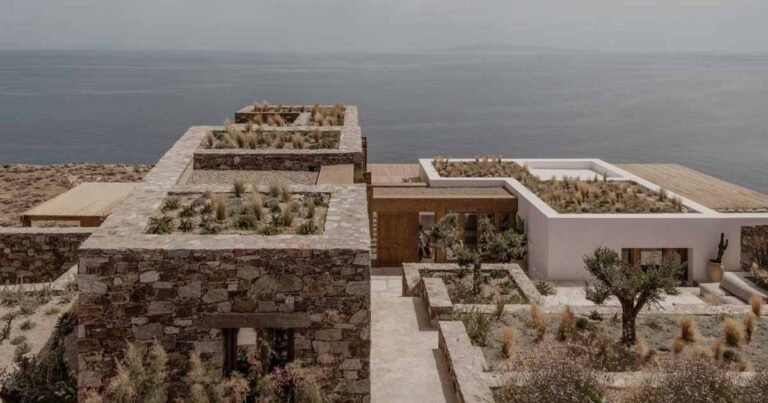Socrates Sculpture Park displays five installations addressing the urgency of climate change
A timber-framed hut with a mylar roof, a hollowed out wooden “coral polyp,” and a tunneled staircase are among the installations on view at Socrates Sculpture Park in Long Island City, New York, as part of the new exhibition Sink or Swim: Climate Futures. The city-owned sculpture park overlooking the East River has displayed public art for over 35 years and this latest exhibition is part of its annual fellowship program, an open-call to artists and designers to support the construction of a project that responds to an annual theme. Recipients receive funding to realize their design proposal and access to fabrication tools and facilities at Socrates Sculpture Park.
In its latest iteration the theme focused on addressing the climate crisis, the phrase “Sink or Swim” evokes the uncertainty of the climate crisis and references carbon sinking, wherein carbon is taken from the atmosphere and trapped in rock or water, and the rising sea levels which will result from melting glaciers. Five artists were chosen as fellows from over 350 applications, Cheyenne Concepcion, Sean Desiree, Koyoltzintli, Randi Renate, and Daniel Shieh. Each one has spent several months designing and constructing their respective installation that takes on the timely theme along with other topics, such as race, gender, and class.
“The works represent a range of interpretations, drawing from diverse communities, traditions, natural and futuristic environments to create unique sculptures and installations,” said Tamsin Dillon, executive director of Socrates Sculpture Park in a press release. “I hope Sink or Swim: Climate Futures, presented by Jess Wilcox our Curator and Director of Exhibitions at the end of her tenure, challenges us to seek solutions and reframe our choices for a more conscious and equitable”
“I’m heartened to have worked with such a talented group of artists who each bring a unique and compelling perspective to confronting climate change,” added Wilcox. “Together these artists’ propose social adaption and resilience, learning from natural world, and reimagining of new and old technologies as necessary steps for living in our future global climate.”

Disappearing St. Malo, designed by Cheyenne Concepcion, emulates the architecture of the bahay kubo, a thatch-roofed, stilted house common in the Philippines. Concepcion’s structure is a double-sloped tin-roofed pavilion covered in reflective, blue mylar streamers resembling confetti. The pavilion’s title recalls the name of the first Filipino settlement in the United States established in 1783 in Louisiana’s bayous, a site that has been consumed by rising sea levels, demonstrating the threat that climate change poses to cultural traditions and historical places.

Sean Desiree designed Let Us Keep You Warm, an upright work that uses locally sourced hemlock timber and aluminum cans to imagine a cold weather shelter for the unhoused. Desiree installed solar powered fans which blow air into black aluminum cans fixed to the installation’s exterior. The three timber walls of the structure bend inward like figures crouching together for warmth. This posture invokes the collective action required to correct or—more realistically—withstand, global climate change.

Ticnu, designed by Ecuadorian artist Koyoltzintli, aligns to the trajectory of the sun and moon, recreating Andean astronomical rituals. The installation evokes the concept of Nepantla or “in-between-ness,” creating an intermediate space between spiritual and corporeal realms. Ticnu consists of a half oval of stone fragments surrounding an inner-circle of ceramic offerings modeled after plants and animals threatened by climate change. These ceramic figures were produced by members of the public in workshops Koyoltzintli held this summer.

Texan artist Randi Renate has designed Are we psychic coral-polyps?, a cedar installation which imitates the structure of a coral-polyp, a seafaring invertebrate creature. Constructed out of cedar planks, the installation provides benches within its enclosed space. The choice of coral as the piece’s primary referent alludes to the symbiotic nature of coral polyps which group together in large colonies creating complex skeleton structures. Similar to Let Us Keep You Warm, Are we psychic coral-polyps? uses a visual metaphor to suggest that collective action is our only recourse in the face of climate change.

Passage to TOI-700 d (the New World), designed by Taiwanese-born artist Daniel Sheih, references TOI-700d, a planet recently discovered by NASA which is believed to have Earth-like and potentially habitable conditions. The piece poses escape to another planet as a far-fetched, yet potentially unavoidable, alternative to the sink-or-swim climate crisis on Earth. The structure takes the form of a staircase encased within a tunnel, a portal to another world.
Sink or Swim: Climate Futures will be on display at Socrates Sculpture Park until March 12, 2023.



